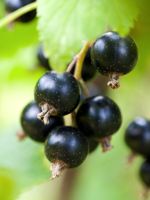Mon-Fri 9am - 5pm Mountain time
Bilberry vs Ben Sarek Black Currant
Vaccinium myrtillus
Ribes nigrum Ben Sarek
CUSTOM GROW
NOT AVAILABLE THIS SEASON - MIGHT RETURN
Bilberry is a native perennial shrub valued for its small, blue-black berries that ripen in mid to late summer. The berries resemble blueberries but have a richer, more tart, and intense flavor. They have long been used for fresh eating, baking, and preserves, while also providing food for birds and mammals. In spring, its delicate pinkish flowers attract bees and other pollinators.
Growing low to the ground, Bilberry forms spreading colonies that create dense understory cover. This growth habit provides food and shelter for wildlife, and its foliage adds seasonal interest by turning red to purple in autumn. With its adaptability and ecological benefits, Bilberry is well-suited for naturalization, ecological restoration, and pollinator gardens.
Ben Sarek Black Currant is a compact, high-yielding Black Currant cultivar, making it ideal for smaller gardens and easy berry picking. The large clusters of flavourful, sweet-tart berries ripen in mid-summer and are perfect for fresh eating, preserves, baked goods, and liqueurs. Plants may start producing some berries after two years, reaching full production in about four to five.
Developed by the Scottish Crop Research Institute, Ben Sarek Black Currant is resistant to powdery mildew and moderately resistant to white pine blister rust. It is self-fertile, meaning it does not require cross-pollination from another variety to produce fruit.
Bilberry Quick Facts
Ben Sarek Black Currant Quick Facts
Toxicity: leaves may be unsafe in high doses

